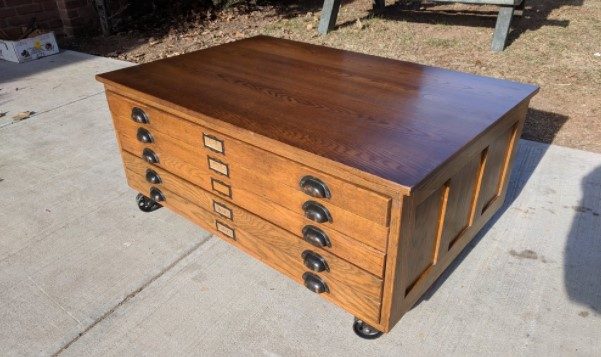Randy Charles is the owner of PaintCentric.com, a website dedicated to providing information, tips, tricks, and news about all things paint. With over 10 years...Read more
Do you happen to work on many paintings at once? If yes, many fresh paintings are vulnerable to weather elements and dust. You dont want your effort wasted.
From a drinking spree that spins out of control to cat hairs, fresh paintings are always at risk.
You can store oil canvases in safe spaces that protect them from environmental elements of life. This can be done by storing paintings vertically, like books on a shelf.
From drying racks to climate-controlled storage units, you can store and preserve oil paintings in several ways. Such units protect paintings from heat and humidity fluctuations. You can opt for drying racks, stack canvas to dry with separators, or build DIY drying racks.
How To Keep Oil Paintings While Drying
A busy day of oil painting will leave your studio with a lot of wet oil painting. You cant leave them just anywhere. You need these paintings stored properly to avoid damage from weather elements, pets, and people.
Drying racks can be found at art stores or could be constructed by an ambitious individual. Below are common types of places to store and dry artwork.

Drying racks
There are several ways to store oil paintings as they dry. The first and easiest way is to use a drying rack. Every artist needs a drying rack in their studio. Drying racks are convenient and provide a secure place to store layers of paintings as they dry.

Depending on the number of wet oil paintings, you can choose drying racks with multiple compartments. If you dont have a budget for drying racks, consider DIY drying racks. Additionally, the art should be stored in a secure room with the right temperature and humidity.
Flat file cabinets
You can also store wet oil paintings in a flat-file cabinet. However, make sure the cabinet size is enough and fits the paintings without squeezing them. If you have more than one painting, consider putting a piece of tracing paper between the paintings to protect them.

Wood shelves and racks
For small artists with a few pieces, you can hang them on top wood shelves and racks. Make sure you use clips to keep the paintings in place.

Mirror boxes and wooden crates
These are also excellent places to store your oil painting while drying. Mirror boxes and wooden crates are large and practically safe.
Typically, you need the paintings to dry out fast but safely. Never put the painting in a hot room to hasten the drying process.
The ideal conditions should be in a dark room with temperatures of between 65-70 degrees F and humidity of 45-55%. Ensure you dont touch the paintings for at least 18-24 hours to avoid running them before they dry.
Change Is The Rule
Your oil painting surface will change in color constantly in response to different light levels. The number of color changes you can expect is directly related to the amount of sunshine/light getting to the painting.
The color changes are invisible to the eyes. This is something painter Robert Gamblin learned years ago. He measured color using a spectrophotometer and tabulated the results in graphs.
While there were no meaningful color changes, he did notice slight up and down color movement. The movements were in response to the quantity of light the paintings received.
The sample charts from the link above show white oil color changes in response to brightness. As you can see in the graphs, the Titanium white color changes over the years in response to light. The brightness value ranges from 0-100, with very little color change over the months.
There are clear dips on sunny and cloudy days. This indicates that the paintings change color when stored in the dark and brought into the light.
Change Of Color From Storage In The Dark
Oil paintings start changing color from the moment an artist completes an oil painting. However, most of these changes are barely noticeable to the eyes. A spectrophotometer can measure the slightest changes from when the painting is dark to when you bring it to light.
These changes are quite common in areas with large and thick paintings. Most paintings tend to reduce lightness when stored in the dark for years. However, this changes when they are brought to light.
For example, a dark-aged sample will change color after years in the dark. However, when brought into the light, it regains its original color when it is put into the dark.
However, any difference in color from storage in the dark would be invisible to the naked eye.
Where Should I Store My Oil Paintings?
The best place to store your oil paintings is in a secure storage unit in a personal facility. You need a self-storage facility that is clean and safe. This is important since storing your paintings determines how long they stay.

For example, humidity and heat can be devastating to most oil paintings. Excessive heat and humidity can cause the canvas to loosen and expand over time. Most paintings develop chips, cracks, and dust accumulation over the years.
You can rent a storage unit for short-term or long-term storage needs. This is because most rental units rarely get visits and are clean and safe. Moreover, most storage units offer 24/7 video monitoring to ensure your paintings are safe and secure.
For high-end value paintings, consider climate-controlled storage units. Such facilities maintain constant heat and temperature, protecting your precious paintings from damage.
Avoid storing oil paintings in the basement and attics. The basements suffer from humidity fluctuations and are at high risk for floods.
Attics also tend to suffer from high-temperature fluctuations.
How Do I Store Oil Paintings On Canvas?
You can store oil paintings on canvas by packaging them correctly. Canvas is a popular material for acrylic and oil paints. While canvas is durable, it is extremely sensitive to light. Make sure you keep it out of direct sunlight. Ive already discussed how UV light can affect paint colors.
Secondly, store your canvas paintings in an upright position. Horizontally-stored canvas sags and becomes loose over time. The thumb rule is to NEVER lay the canvas flat while storing. Moreover, keeping your painting flat prevents dust and debris from accumulating.
Make sure the canvas is stored in a cool and dry place. Moist places will lead to mold developing on your pieces. In addition, store the canvas away from heat. Heat expands and contracts the canvas making it loose over time.
You can also protect your canvas using a piece of cloth. Use old cloth (bed sheets) to protect your artwork from cobwebs, dust, and grime.
Lastly, avoid placing the canvas on the floor. You never know the kinds of crawling insects that might pass over it at night.
Related: How To Paint Over Peeling Paint?
What is the Way to Store Oil Paintings For The Long Term?
You can store oil paintings long-term by looking for a secure storage facility with minimal contact.
First, wrap the painting in packages to avoid direct contact with elements. Packing your painting keeps it clean and safe.

Secondly, select a suitable storage facility with the right temperature and humidity settings. You can consider climate-controlled facilities because humidity and temperatures are kept constant. Get a local storage facility that is safe and secure.
Can You Revive Dried Oil Painting?
Although your painting is dry, you can revive the oils to continue working. Revive dry oil paint by applying turpentine on a rag and letting it soak on the painting for a few minutes. Ensure you wear gloves and a protective mask since turpentine materials can be toxic when inhaled.
Add more turpentine as necessary until the paint softens. You can apply turpentine to a brush and gently brush the painting until the oil softens.
Conclusion
Storing oil paintings while drying is easier when you know the right place and storage conditions. Never let your precious artworks go to waste because of a simple storage mistake. Youve already put in a lot of effort to let your painting go to waste.
Be content and invest in your studios quality drying racks and a secure storage facility. Limit access and touching of the painting for at least 24 hours for the oil paint to dry. Once the painting is dry, wrap it to protect contact with elements before storing it in a secure storage facility.

Randy Charles is the owner of PaintCentric.com, a website dedicated to providing information, tips, tricks, and news about all things paint. With over 10 years of experience in the painting industry, Randy has become an expert in the field and is passionate about helping others learn more about painting. He has written numerous articles on the subject and is committed to providing accurate and up-to-date information to his readers.
- Latest Posts by Randy Charles
-
How to get paint off a mirror?
- -
How much does it Cost to Paint a Car? – All You Know is Here
- -
How much does Car Paint Cost? – Get To Know Here
- All Posts

Yes, I understand you. In it something is also to me it seems it is very excellent thought. Completely with you I will agree.
Just that is necessary. Together we can come to a right answer. I am assured.